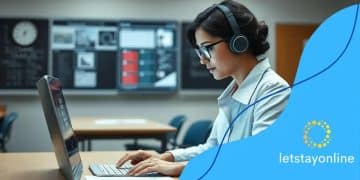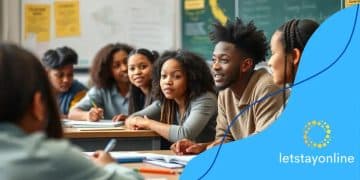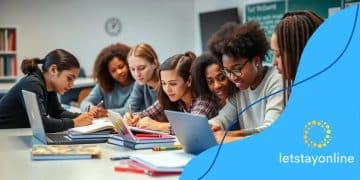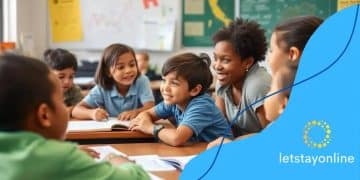The impact of remote learning on student performance

The impact of remote learning on student performance is significant, as it offers flexibility, personalized learning experiences, and greater access to resources, while also presenting challenges like decreased engagement and the need for self-discipline.
The impact of remote learning on student performance has become a hot topic in education circles. Have you ever wondered how this shift affects students? Let’s dive into the details to find out.
Understanding remote learning and its evolution
Understanding remote learning is crucial as education continues to evolve. This method has dramatically changed how students engage and learn. Students today often juggle technology and learning in ways that previous generations never experienced.
The evolution of remote learning has roots in technology advancements. With the rise of the internet, educational institutions began exploring online classes. This shift opened up opportunities for many students, especially those who prefer a more flexible schedule.
Key milestones in remote learning
Several key milestones have shaped remote learning:
- The introduction of online platforms in the late 1990s.
- The development of interactive tools like video conferencing.
- The shift to full online classes during the COVID-19 pandemic.
These milestones mark significant points in the trajectory of education. Each phase brought new challenges and innovations. For instance, during the pandemic, educators had to adapt quickly. Many embraced online teaching tools to ensure students could continue their education.
The current landscape of remote learning
Today, remote learning is a vital part of our education system. It offers various modes, such as:
- Synchronous classes, where students learn in real-time.
- Asynchronous learning, allowing students to learn at their own pace.
- Blended learning, which combines online and in-person sessions.
This diversity caters to different learning styles and needs. As technology continues to improve, we can expect even more flexible and effective methods of remote education.
Overall, understanding the evolution of remote learning helps us appreciate its impact on student performance. With ongoing advancements, remote learning is set to remain an essential component of education.
Key factors affecting student performance

Key factors affecting student performance are crucial to understand, especially in the context of remote learning. Several elements come into play that can influence how well students learn and engage.
First, access to technology is a major factor. Not all students have the same devices or internet connections at home. This can create disparities in learning opportunities. Schools are increasingly recognizing this and are working to provide resources to those in need.
Engagement and motivation
Another important aspect is student engagement. When students feel motivated, they are more likely to succeed. Remote learning can sometimes lessen engagement due to lack of direct interaction with teachers and peers.
- Interactive lessons can increase participation.
- Clever use of technology may help keep students interested.
- Setting clear goals can motivate students to perform better.
Moreover, the learning environment at home plays a significant role. A quiet and dedicated space allows students to focus better. In contrast, distractions can hinder performance. Parents and caregivers can help by creating an environment conducive to learning.
The role of teacher support
Teacher support is essential in both traditional and remote settings. Frequent feedback and encouragement can make a big difference in student performance. The use of online tools for communicating with teachers also enhances support.
- Regular check-ins can help students stay on track.
- Personalized instruction meets students’ individual needs.
- Teachers can provide resources for additional help, if necessary.
In essence, understanding these key factors gives insight into how remote learning can be improved to boost student performance in the long run.
Comparing traditional vs remote learning outcomes
When comparing traditional and remote learning outcomes, it’s essential to look at various factors that influence effectiveness. Both methods have unique strengths and challenges that affect how students learn.
In traditional learning, students attend physical classrooms, allowing for direct interaction with teachers and peers. This setting often fosters social skills and creates a sense of community. However, it can also be limited by geography and classroom size.
Benefits of traditional learning
Traditional learning offers several benefits, including:
- Immediate feedback from teachers during lessons.
- Structured environments that can enhance focus.
- Opportunities for group work and collaboration.
Students often report enjoying the face-to-face interactions in a traditional classroom. However, this model can also come with challenges, such as varying quality of instruction and reliance on a fixed schedule.
Advantages of remote learning
On the other hand, remote learning provides flexibility for students. They can learn from anywhere, which is particularly beneficial for those with busy schedules or family commitments. It also allows students to learn at their own pace, providing access to diverse online resources.
- Access to global resources and experts.
- Customized learning experiences through adaptive technologies.
- The ability to balance studies with personal responsibilities.
However, remote learning does present challenges, such as isolation and difficulty in staying engaged. The need for self-discipline becomes more critical. Some students struggle without the structured environment of a classroom.
In conclusion, both traditional and remote learning have their merits and drawbacks. The best approach often depends on the individual needs and preferences of the students.
Strategies for effective remote learning
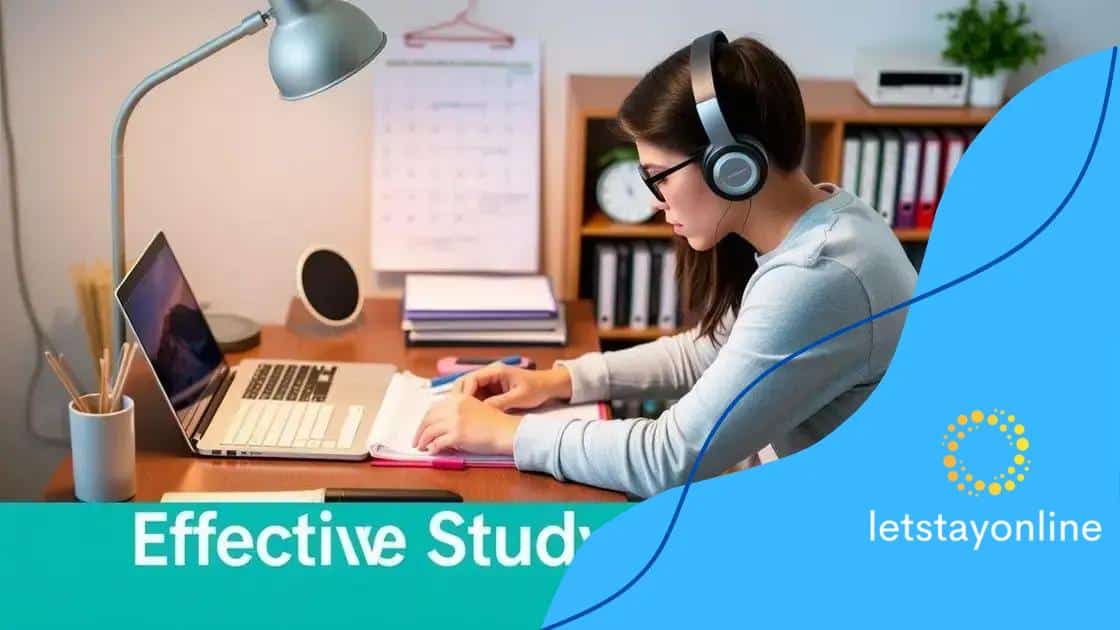
Strategies for effective remote learning are essential for enhancing student engagement and improving performance. With the right techniques, students can maximize their learning potential and achieve success.
One effective strategy is creating a dedicated learning space. When students have a quiet and organized area, they can focus better on their studies. This space should be free from distractions and equipped with necessary materials.
Utilizing technology effectively
Another key strategy involves leveraging technology to aid learning. Online tools and resources can significantly enhance the learning experience. Some important technologies to consider are:
- Interactive learning platforms that encourage participation.
- Video conferencing tools for real-time discussions.
- Digital libraries and resources for easy access to information.
Using these technologies can keep students engaged and make learning more interactive. It also allows for flexible learning schedules to accommodate different needs.
Setting goals and routines
Setting specific goals helps students stay motivated. When they have clear targets, they are more likely to focus on their studies. Establishing a routine can also provide structure to their day.
- Daily schedules can help students allocate time effectively for studying.
- Regular breaks can maintain energy levels and improve concentration.
- Track progress to celebrate achievements and stay motivated.
Finally, maintaining communication with teachers and peers is vital. Regular check-ins with instructors can help clarify doubts and reinforce learning. Collaboration with classmates can facilitate discussions and strengthen understanding.
In summary, employing these strategies can lead to more effective remote learning experiences. By focusing on environment, technology, goals, and communication, students can enhance their learning outcomes.
The future of education: remote learning trends
The future of education is increasingly leaning towards remote learning. Emerging trends show how technology will shape how students learn in the coming years. As schools adapt, understanding these trends is vital for students and educators alike.
One significant trend is the rise of personalized learning. With advancements in technology, students can now learn at their own pace. This method accommodates different learning styles, allowing for a more tailored educational experience.
Incorporation of AI and machine learning
Another crucial trend involves the use of artificial intelligence (AI) and machine learning in education. These technologies can analyze student performance and suggest areas for improvement.
- Customized learning plans based on individual progress.
- Automated feedback on assignments to enhance learning.
- Smart tutoring systems that provide additional support.
These innovations aim to create a more effective and engaging learning environment.
Blockchain technology in education
Blockchain technology is also making waves in education. It offers secure and transparent record-keeping for credentials and achievements.
- Digital diplomas can be easily verified by employers.
- Student progress can be securely tracked over time.
- Enhanced data security for sensitive information.
This technology might revolutionize how educational institutions manage student records, making the process more efficient and trustworthy.
Additionally, hybrid learning models that combine in-person and remote education are gaining traction. Schools are looking for ways to create flexible learning environments that can adapt to various circumstances, ensuring that students receive quality education, regardless of location.
As the future unfolds, these remote learning trends will continue to evolve. Embracing these changes will be crucial for students, educators, and institutions alike.
FAQ – Frequently Asked Questions about Remote Learning Trends
What is the impact of AI on remote learning?
AI enhances remote learning by providing personalized learning experiences and offering feedback tailored to individual student needs.
How can technology improve student engagement?
Technology provides interactive tools that make learning more engaging, allowing students to participate actively in their education.
What are hybrid learning models?
Hybrid learning models combine in-person and online education, offering flexibility to accommodate different learning styles and commitments.
Why is blockchain important in education?
Blockchain technology ensures secure and transparent record-keeping for student achievements, making credential verification easier for employers.



